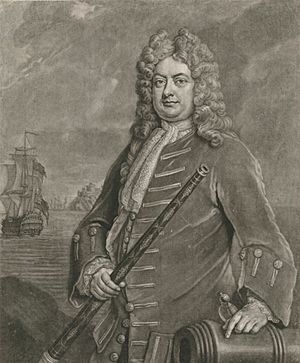Robert Hughes (Royal Navy officer, died 1729) facts for kids
Quick facts for kids
Robert Hughes
|
|
|---|---|
| Died | 14 March 1729 London, England |
| Buried |
St Paul's, Deptford, England
|
| Allegiance | Kingdom of Great Britain |
| Service/ |
Royal Navy |
| Years of service | c.1692–1729 |
| Rank | Rear-Admiral |
| Commands held |
|
| Battles/wars | |
| Children | 2 |
| Relations | Sir Richard Hughes (nephew) Sir Robert Calder (grandson) |
Robert Hughes (died 14 March 1729) was an important officer in the Royal Navy. He joined the navy in the late 1600s. He served as a lieutenant on large warships during the Nine Years' War. In 1697, he became a captain.
His first ship was HMS Flamborough. With this ship, he captured several privateers near Dunkirk at the start of the War of the Spanish Succession. Later, he commanded HMS Winchester. In 1727, he was promoted to Rear-Admiral. He helped the Baltic Fleet convince Russia not to go to war with Sweden. Robert Hughes passed away in 1729 in London.
Contents
Robert Hughes was born in the late 1600s. He had a brother, Captain Richard Hughes, who was also a naval officer. This made Robert the uncle of Sir Richard Hughes, 1st Baronet. Robert Hughes joined the navy during the Nine Years' War. On December 19, 1692, he became a lieutenant.
In 1693, he was the second lieutenant on HMS Suffolk. This was a large warship with 70 guns. By 1695, he was the main lieutenant on HMS Queen. This huge ship had 100 guns and was the main ship for Admiral Sir Cloudesley Shovell. After this, Hughes became a commander. Then, on June 28, 1697, he was promoted to captain.
Leading Ships and Squadrons
When Robert Hughes became a captain, he was given command of HMS Flamborough. This ship had 24 guns. He stayed with this ship even after the Nine Years' War ended. In 1698, Flamborough escorted a group of ships through the White Sea. In 1699, it served off the coast of Ireland.
In 1701, Flamborough guarded the fisheries near Great Yarmouth. The War of the Spanish Succession began that same year. Flamborough was sent to patrol the North Sea. In 1702, Captain Hughes captured several small but successful privateers near Dunkirk. A writer named John Charnock said Hughes showed "great activity and diligence."
Serving in the Mediterranean
Later in 1702, Hughes moved to command HMS Winchester. This ship had 50 guns. In 1703, Winchester joined the Mediterranean Fleet. This fleet was led by Admiral Shovell. By September, Hughes was commanding HMS Poole, a 32-gun ship. The fleet then returned to England.
In 1704, Hughes returned to command Winchester. The ship joined a group of ships led by Rear-Admiral William Whetstone in the English Channel. They stayed there into 1705. The next year, Hughes and Winchester joined the Mediterranean Fleet again. This fleet was led by Admiral Shovell and Admiral of the Fleet Sir John Leake.
Admiral Leake made Hughes a commodore. This meant Hughes led a small group of ships. His job was to guard the entrance to the Straits of Gibraltar. He did this job very well. He captured or destroyed two enemy ships and a small sailing vessel. He continued to serve off Gibraltar until 1709.
Later Commands
After Gibraltar, Hughes and Winchester moved back to the English Channel. On November 27, he captured a privateer from Flushing. In 1711, Hughes was given command of HMS Kent. This 70-gun ship served in the Channel. It was the main ship for Rear-Admiral Sir Thomas Hardy. On February 23, 1712, Kent captured a privateer called La Revanche.

In 1715, Hughes moved to command HMS Plymouth, a 60-gun ship. He joined Admiral Sir John Norris's Mediterranean Fleet. He stayed there until 1717. Then, he moved to HMS Devonshire, an 80-gun ship. We don't know much about his service after this until 1726. In 1726, he commanded HMS Hampton Court, a 70-gun ship. This ship was part of Vice-Admiral Sir Charles Wager's Baltic Fleet.
Becoming a Rear-Admiral
Robert Hughes was promoted to Rear-Admiral on April 21, 1727. He continued to serve on Hampton Court, but now as a flag officer, not just the captain. Right after his promotion, Hughes joined a fleet led by Admiral Norris. Hughes was the third in command.
The fleet had twelve large warships. Their mission was to go to the Baltic Sea. They needed to convince Russia not to attack Sweden. The fleet arrived in Copenhagen on May 12. Their presence made such a strong impression on Russia that Russia decided not to attack Sweden. Russia even put its navy away. Hughes and the fleet returned to England without firing a single shot. The fleet arrived home in early January 1728. Hughes did not serve actively after this. He passed away on March 14, 1729, in London from a leg infection. He was buried in St Paul's, Deptford, where many of his family members were also buried.
Family Life
Robert Hughes was married to a woman named Lydia. They had two daughters. These daughters inherited his property. One daughter, Alice, married Sir James Calder, 3rd Baronet. Alice had four sons, including Admiral Sir Robert Calder. His other daughter, Katherine, married John Sayer. They had a son named Vice-Admiral James Sayer.

